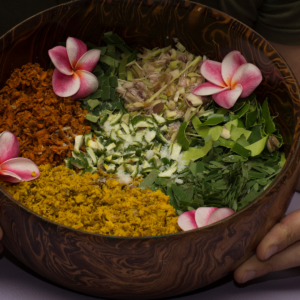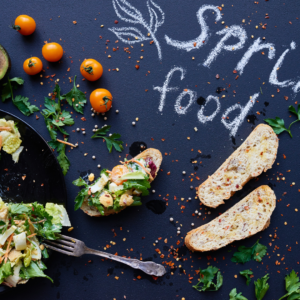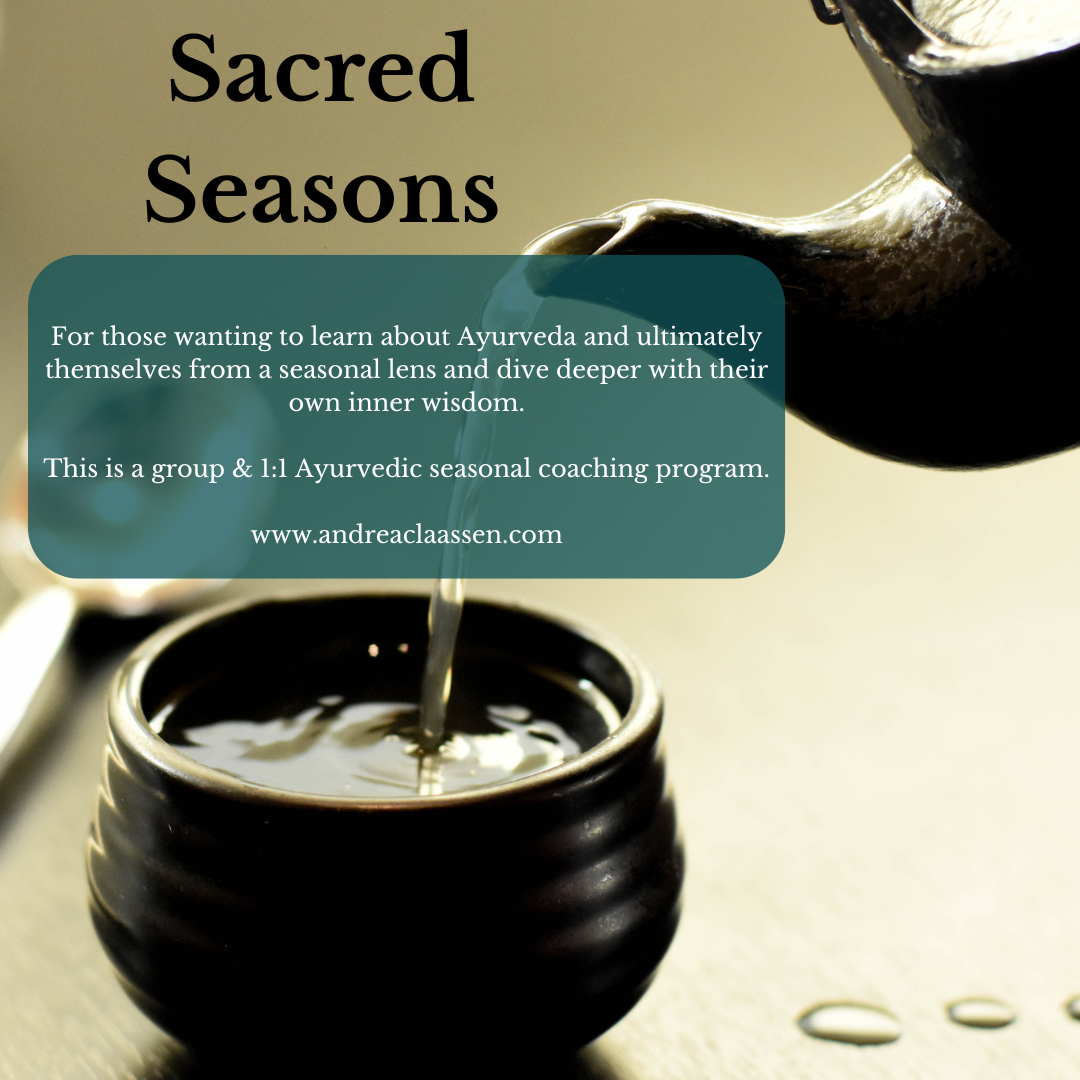Vasant Ritu (Spring)
Vasant Ritu in Ayurveda is related to the spring season. In India those dates range from Mid-March to Mid-May. Those dates might be different based on the climate where you live. In Ayurveda you always go what is happening outside of your window vs a set date on a calendar.
The dosha most predominant during this season is the kapha dosha. When we look at what gunas or qualities are occurring at this time we often observe; dry, heavy, cold, and sticky qualities happening outside. The qualities happening outside in mother nature also affect what’s happening inside our bodies.
The yoga asana poses were chosen to help you reduce the accumulating kapha but not to provoke the pitta in the body at this season. The emphasis will be on extensions and backbends on your belly. The rituals during the spring season are about movement. When we think about the spring season we often think about colds, coughs and congestion. Kapha dosha does best when we can stay active so things don’t become stagnant in the mind or body.
Our remedies during this season will emphasis tips for spring allergies and finding the right exercise for your body during this season.

Understanding Vasant Ritu
Vasant Ritu is known as the spring season. The spring season in Ayurveda is all about movement, keeping your agni high, and being in nature. It’s a time to move the body, start transitioning your foods to be lighter in nature, and keep the mind active. If we reflect back to the three gunas we want to make sure we don’t bring in as much tamas at this time. Which is why it’s important to keep both the mind and body active so you don’t feel heavy, dull and unmotivated.
A few Vasant Ritu practices are yoga nidra, enjoying ginger and honey tea and dry brushing to incorporate during these sometimes cooler months.
Journaling prompts for the spring season to get you started planting new seeds in your life;
- What practices need to shift in my life so I feel more energized this season?
- What seeds am I planting this spring season that I want to watch grow over the next few months?
- How can I develop a better relationship with exercise or movement?
- How can I bring in more sattva (harmony & balance) to my life this season?
Another practice to focus on during the spring season is your digestion, keeping your agni high. In the spring season the foods to emphasis in your diet are; pungent, bitter, astringent, sharp, penetrating, and light. Some of those foods will be asparagus, bitter greens, ginger, honey, mangos, berries, radishes, amaranth, barley, mung dal, and black beans.
Your Vasant Ritu Plan Overview
In the Vasant Ritu season you want to pacify the kapha dosha. Often it is a damp, cooler, heavy season. If we think about what is happening outside you might have more mud, stagnant water, and cooler temperatures. To combat those qualities you will want to have more drying, lighter and warmer qualities introduced into your lifestyle. That might look like eating warm, cooked lighter vegetables, more broth based soups, making sure you dress for the weather and wear a jacket on those cooler days.
One of the best ways to help reduce kapha accumulation is to move your body. Exercise is vital as part of your routine during the spring season. Starting your day off with a good morning routine that includes a more vigorous yoga asana practice, lifting weights, or going for a brisk walk is ideal.
The food you will enjoy should be lighter in nature and seasonal. Look at what foods are growing in your area at this time of the year. Add those into your seasonal recipe rotation. Another seasonal ritual you could incorporate daily is enjoying a cup of ginger honey tea.

Sample Daily Routine
A sample morning routine in the spring season wake up at 6am with the sunrise. Use your tongue scraper and brush your teeth. Do 1-3 round of kapalabhati for 30 breaths. Go for a brisk morning walk or perform your workout routine. Perform 5 rounds of sun salutations or check out the yoga asana section for another idea. Finish with right nostril breathing 10 times. To perform right nostril breathing just place your index finger on the bridge of the left nostril and take 10 deep breaths breathing in & out through the right nostril. Enjoy your breakfast and start your day.
Sample Daily Menu
In the spring season incorporating the foods that are grown near you is the first items to add to your seasonal menu. Often asparagus, ginger, collard greens are wonderful for pacifying the kapha dosha in the spring. Enjoy a grapefruit with a pinch of cardamom, ginger and honey on it for breakfast. Eating fruit alone is recommended in Ayurveda. Fennel is another useful herb to help with post digestion issues. You can slightly toast fennel seeds and eat them before or after meals, you can roast an entire fennel bulb and enjoy with your meal, or you can make a fennel tea to aid in digestion.
Sample Daily Ritual
In the spring honey and ginger are a perfect match for the kapha dosha. You can pour yourself a cup of ginger and honey tea at the start of your day, or as a midday check-in point. You might want to take a 10 minute pause in your day to set an intention and to slowly sip on your tea as a way to slow down and tune into your body. One mindful tip to remember when working with honey in Ayurveda it should never be added to boiling hot water. It is said that it will clog the subtle channels of the body, and can cause digestive disruption with long term use in that manner. It’s best to let your water cool and then add in the honey.
Modification Tips
Your daily routine will look similar no matter your dosha this season with one caveat. If you’re predominately a vata or pitta dosha you would also want to add in a meditation practice into your morning. In the spring kapha dosha does’t always need to sit for a meditation as that can cause stagnation in the body in an already grounded person. If you feel a bit ungrounded, or scattered adding in a 5-20 minute meditation is advised.
No matter your dosha you will always eat with your digestion in mind. Just because asparagus, ginger, and collard greens are advised at this time doesn’t mean they are right for you. Always pay attention to how foods make you feel after you eat them. It can change seasonally so keeping a food journal can help those first few weeks of a new season to see how you feel after each meal.
Every dosha can benefit from a honey ginger tea, even the pitta dosha. Ginger is initially warming to the body but has a cooling affect after digestion. That is why pitta can add in ginger to their foods and usually be okay with it. If there is a strong pitta imbalance going on in the body reducing your ginger amount is usually advised to reduce the extra heat in the body.

Preparing For Vasant Ritu
To prepare yourself of the coming Vasant Ritu season you will want to start monitoring your digestion, energy and mood. Notice how you are feeling this season and how you might need to find your inner balance based on what qualities you feel in your mind and body.
For the upcoming yoga asana sequence and ritual and remedy practices you will need a dry brush, neti pot and salt, and rose petals and chamomile buds. You might also like a yoga mat, and yoga blocks if those are used in your practice.
When we transition into a new season you can think of this time as a good time to honor a lifestyle change. In Ayurveda, you want to evolve with the seasons. Every new season there is new opportunity to look at what is working and what is not in your life. You can simply add in one of these remedies as a weekly or daily practice to start with. If these are all brand new practices to you, take your time. It’s best to slowly adapt change into your lifestyle vs trying to overhaul it all at once. For example, towards the end of the late winter season you might start to cook with lighter foods, and start to move your body a little bit more to prepare for the upcoming seasonal shift. Often if you slow down to notice the energy happening with mother nature you will feel called to make these subtle shifts to keep yourself in balance this spring season.
Healthy Living Tips for Vasant Ritu
The best way to form the new habits in the spring season is to make time in your schedule for them and to habit batch. Habit batching is where you perform 2 or more new habits back to back as part of your daily routine. You can incorporate the neti pot at the start of your day after you brush your teeth. Next batch the neti pot with your morning movement practice. After you finish your movement practice, you can dry brush before you have your morning shower.
Finally you can incorporate the facial into your routine by having a nightly “spa” night. You pick one night a week where you pamper yourself with a facial, abhyanga practice and foot massage. It can be your Ayurvedic self-care ritual.
If you know you time might be an issue to commit to a weekly “spa” night, you might try a practice under the new or full moon. This is a great way to add ritual into your lifestyle and honoring mother nature at the same time. The new moon is a time of inner reflection so you might pair your spa night with a journal practice, writing down 3-5 intentions you would like to see happen over the next month. The full moon is a time of connection, energy, and releasing. At this time you might journal about the areas in your life that you want to release and let go of that are no longer serving you.

End of Season Takeaways
The Vasant Ritu season is typically from Mid-March-Mid-May. The spring season is associated with the kapha dosha and the gunas at this season are; dry, heavy, cool, and sticky. Everyone will have a different experience based on your climate needs, as well as your doshic needs during that season of your life. Each year the spring season will look and feel different based on your imbalances. Knowing one season you might need more movement while other spring seasons you might need more meditation.
Key Takeaways
- Vasanat Ritu is associated with the spring season and kapha dosha
- Rituals & Remedies at this are focused on reducing aggravation of kapha
- Yoga asana practices at this time are focused on extensions and backbends on your belly
- Movement in the spring season is key to keep your mind and body from getting stuck and stagnant.
As you prepare for the upcoming seasonal switch into the summer season you will take mother natures lead. If things start to feel warmer, and more intense earlier in May you might already start to embody the summer practices. If spring takes it’s time you will continue to follow the more warming practices to keep balancing the kapha energy.

Dive deeper into ayurvedic spring tips
Learn how to balance yourself during this season by joining the Seasonal Living Collective.
view + leave comments . . .